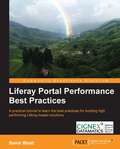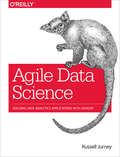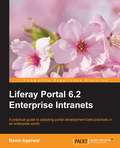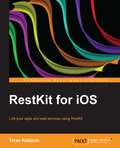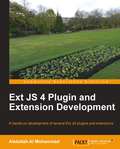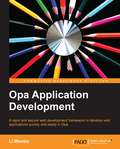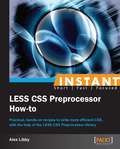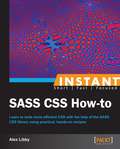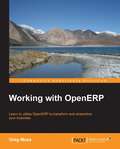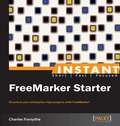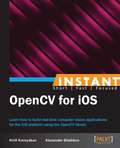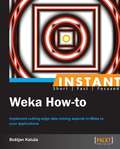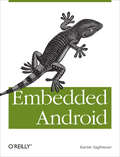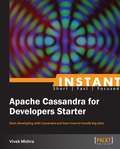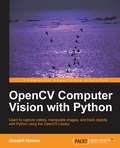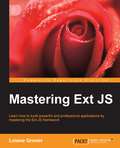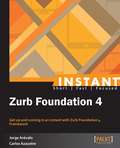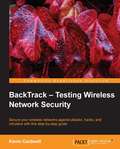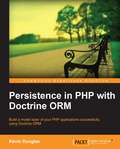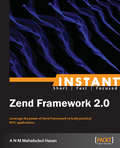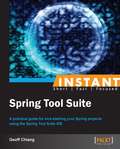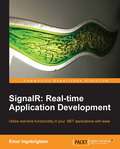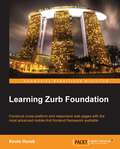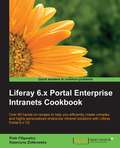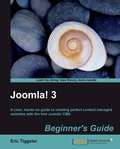- Table View
- List View
Liferay Portal Performance Best Practices
by Samir BhattA step-by-step tutorial on implementing Liferay- based portals to learn performance best practices.The book is good for Liferay portal developers and architects who want to learn performance best practices for implementing Liferay- based solutions. It is assumed that you have a working knowledge of the Liferay portal.
Agile Data Science
by Russell JurneyMining big data requires a deep investment in people and time. How can you be sure you're building the right models? With this hands-on book, you'll learn a flexible toolset and methodology for building effective analytics applications with Hadoop. Using lightweight tools such as Python, Apache Pig, and the D3.js library, your team will create an agile environment for exploring data, starting with an example application to mine your own email inboxes. You'll learn an iterative approach that enables you to quickly change the kind of analysis you're doing, depending on what the data is telling you. All example code in this book is available as working Heroku apps. Create analytics applications by using the agile big data development methodology Build value from your data in a series of agile sprints, using the data-value stack Gain insight by using several data structures to extract multiple features from a single dataset Visualize data with charts, and expose different aspects through interactive reports Use historical data to predict the future, and translate predictions into action Get feedback from users after each sprint to keep your project on track
Liferay 6.2 Intranet Portal Development Guide
by Navin AgarwalThis book is for anyone who is interested in the Liferay Intranet Portal. This book is for both beginners and more experienced portal developers who need to create an enterprise intranet portal for their business. It will be handy for IT professionals who know the basics of how the portal technology works and need to integrate different open source technologies.
RestKit for iOS
by Taras KalapunA step-by-step, example-based guide to learning how you can link your apps and web services using RestKit.This book is for iOS developers of all levels who are interested in boosting their productivity by utilizing third party libraries and who have a willingness to learn how to build RESTful apps using the RestKit framework. A basic knowledge of Objective-C is required as well as a simple understanding of how to use CoreData.
Ext JS 4 Plugin and Extension Development
by Abdullah Al MohammadThis is a step-by-step tutorial that practically teaches Ext JS plugin and extension development through sample examples that increase in complexity.Ext JS 4 Plugin and Extension Development is ideal for experienced ExtJS developers who want to expand their knowledge in developing plugins and extensions. This book is also for those developers who are new to ExtJS development, with at least some knowledge on ExtJS basics.
Opa Application Development
by Li WenboIt is a tutorial guide to learning how to use Opa with JavaScript, Nodejs, and MongoDB to develop web applications easily and effectively.If you are a web developer who wants to get started with the Opa framework and build web applications with it? Then this book is for you. Web development experience is assumed and would be helpful.
Instant LESS CSS Preprocessor How-to
by Alex LibbyFilled with practical, step-by-step instructions and clear explanations for the most important and useful tasks. Get the job done and learn as you go. A how-To book with practical recipes accompanied with rich screenshots for easy comprehension.This book takes the How-to series approach to help you learn most important tasks through recipes This book is ideal for those new to using CSS Preprocessors such as LESS, and who are looking to get a good grounding in how to use LESS. It's assumed you will have some experience in using HTML and CSS already; it is likely you will be responsible for maintaining at least one website (the larger the better), and are keen to learn how you can use LESS to help make it easier to manage your CSS styles. Although this book does incorporate some additional code using Modernizr, it is not essential to have had any previous experience with Modernizr.
Instant SASS CSS How-to
by Alex LibbyFilled with practical, step-by-step instructions and clear explanations for the most important and useful tasks. Get the job done and learn as you go. This book is filled with practical, hands-on recipes to help you write SASS quickly and more efficiently.This book is great for those new to using CSS pre-processors such as SASS, and who are looking to get a good grounding in how to use SASS. It's assumed you will have some experience in using HTML and CSS already; it is likely you will be responsible for maintaining at least one website (the larger the better), and are keen to learn how you can use SASS to help make it easier to manage your CSS styles. Although SASS is powered by Ruby, it is not essential to already be familiar with Ruby for the purposes of completing the recipes in this book.
Working with OpenERP
by Greg MossThis book is a practical, hands-on guide that provides the reader with a number of real-world examples and step-by-step instructions."Working with OpenERP" is written to make it easy for even a non-technical business person to begin implementing OpenERP in their business. This book uses real-world examples and is perfect for people who have never implemented an ERP system before or used OpenERP, or for those who would like to learn more advanced features, such as creating your own custom modules.
Instant FreeMarker Starter
by Charles ForsytheGet to grips with a new technology, understand what it is and what it can do for you, and then get to work with the most important features and tasks.A simple Starter approach introducing new concepts and terms through the hands-on building of templates for Java APIs.If you are a dynamic web developer or a Java-based apps developer new to FreeMarker, then this book will provide invaluable guidance to get your new project started on the right track. If you have started using FreeMarker and find it confusing or complicated, this book will be a guided tour that will show you how to conquer complexity and create a template-based view layer with an elegant architecture.The book is also aimed at those who have elementary web development skills and basic Java programming knowledge. Readers should also have a conceptual understanding of the MVC model.
Instant OpenCV for iOS
by Kirill Kornyakov Alexander ShishkovFilled with practical, step-by-step instructions and clear explanations for the most important and useful tasks. This book uses a very practical approach, with each recipe and their associated sample projects or examples focusing on a particular aspect of the technology.This book is intended for OpenCV developers who are interested in porting their applications to the iOS platform. Basic experience with OpenCV, computer vision, Objective C, and other iOS tools is encouraged.
Instant Weka How-to
by Bostjan KaluzaFilled with practical, step-by-step instructions and clear explanations for the most important and useful tasks. A practical guide with examples and applications of programming Weka in Java.This book primarily targets Java developers who want to build Weka's data mining capabilities into their projects. Computer science students, data scientists, artificial intelligence programmers, and statistical programmers would equally gain from this book and would learn about essential tasks required to implement a project. Experience with Weka concepts is assumed.
Embedded Android
by Karim Yaghmour<p>Embedded Android is for Developers wanting to create embedded systems based on Android and for those wanting to port Android to new hardware, or creating a custom development environment. Hackers and moders will also find this an indispensible guide to how Android works.</p>
Instant Apache Cassandra for Developers Starter
by Vivek MishraGet to grips with a new technology, understand what it is and what it can do for you, and then get to work with the most important features and tasks.A concise and example driven book that will help you in transitioning from beginner to Cassandra skilled developer.Instant Apache Cassandra for Developers Starter is a must-read if you want to learn how to leverage Cassandra to create powerful big data solutions. For the examples in the book you should have a basic familiarity with Java, and be able to implement and run Java applications as well as basic UNIX commands.
OpenCV Computer Vision with Python
by Joseph HowseA practical, project-based tutorial for Python developers and hobbyists who want to get started with computer vision with OpenCV and Python.OpenCV Computer Vision with Python is written for Python developers who are new to computer vision and want a practical guide to teach them the essentials. Some understanding of image data (for example, pixels and color channels) would be beneficial. At a minimum you will need access to at least one webcam. Certain exercises require additional hardware like a second webcam, a Microsoft Kinect or an OpenNI-compliant depth sensor such as the Asus Xtion PRO.
Mastering Ext JS
by Loiane GronerDesigned to be a structured guide, Mastering Ext JS is full of engaging examples to help you learn in a practical context.This book is for developers who are familiar with using Ext JS who want to augment their skills to create even better web applications.
Instant Zurb Foundation 4
by Jorge Arevalo Carlos AzaustreA quick and easy guide that follows a practical approach to rapidly create responsive web pages using Foundation 4 framework, following the mobile-first philosophy.If you are a web developer who wants to get the most out of your HTML5/CSS/JavaScript skills, this book is ideal for you. It is assumed that you will have some experience with these languages, but for those who don't, you can also be up and running in an instant.
BackTrack – Testing Wireless Network Security
by Kevin CardwellWritten in an easy-to-follow step-by-step format, you will be able to get started in next to no time with minimal effort and zero fuss.BackTrack: Testing Wireless Network Security is for anyone who has an interest in security and who wants to know more about wireless networks.All you need is some experience with networks and computers and you will be ready to go.
Persistence in PHP with the Doctrine ORM
by Kévin DunglasPersistence in PHP with the Doctrine ORM is a concise, fast, and focused guide to build a blog engine with advanced features such as native queries and lifecycle callbacks. This book is primarily intended for PHP developers and architects who want to increase their skills in the field of Persistence and ORM to map the data they are working on to objects they are using in programming. Basic knowledge of databases and PDO and working knowledge of PHP namespaces is a prerequisite.
Instant Zend Framework 2.0
by A N HasanGet to grips with a new technology, understand what it is and what it can do for you, and then get to work with the most important features and tasks. This book is fast-paced, practical guide that will provide step-by-step instructions for building a practical database-driven MVC application using Zend Framework 2.This book is for developers who possess entry level knowledge or who have no prior experience with Zend Framework. An understanding of object-oriented programming is important and experience with namespaces will be required.
Instant Spring Tool Suite
by Geoff ChiangFilled with practical, step-by-step instructions and clear explanations for the most important and useful tasks. A tutorial guide that walks you through how to use the features of Spring Tool Suite using well defined sections for the different parts of Spring.Instant Spring Tool Suite is for novice to intermediate Java developers looking to get a head-start in enterprise application development using Spring Tool Suite and the Spring framework. If you are looking for a guide for effective application development using Spring Tool Suite, then this book is for you.
SignalR: Real-time Application Development
by Einar IngebrigtsenThis step-by-step guide gives you practical advice, tips, and tricks that will have you writing real-time apps quickly and easily.If you are a .NET developer who wants to be at the cutting edge of development, then this book is for you. Real-time application development is made simple in this guide, so as long as you have basic knowledge of .NET, a copy of Visual Studio, and NuGet installed, you are ready to go
Learning Zurb Foundation
by Kevin HorekIf you are a web designer, developer, or anyone who is interested in building responsive websites, then this book is a must-have. Basic knowledge of CSS, HTML, and JavaScript is required.
Liferay 6.x Portal Enterprise Intranets Cookbook
by Piotr Filipowicz Katarzyna ZiolkowskaIf you are a Java developer or administrator with a technical background and want to install and configure Liferay Portal as an enterprise intranet, this is the book for you. In short, reusable recipes help you realize business goals as working features in Liferay. This book will also give you useful hints on how to easily improve the default functionality of the system and its performance.
Joomla! 3 Beginner’s Guide
by Eric TiggelerWritten with a fast-paced but friendly and engaging approach, this Packt Beginner's Guide is designed to be placed alongside the computer as your guide and mentor. Step-by-step tutorials are bolstered by explanations of the reasoning behind what you are doing. You will quickly pick up the necessary skills, tips, and tricks for building a successful Joomla! website.This book is written for beginners to website design. By the end of the book you will have built a complete custom content managed website, and be ready to build any kind of website.
